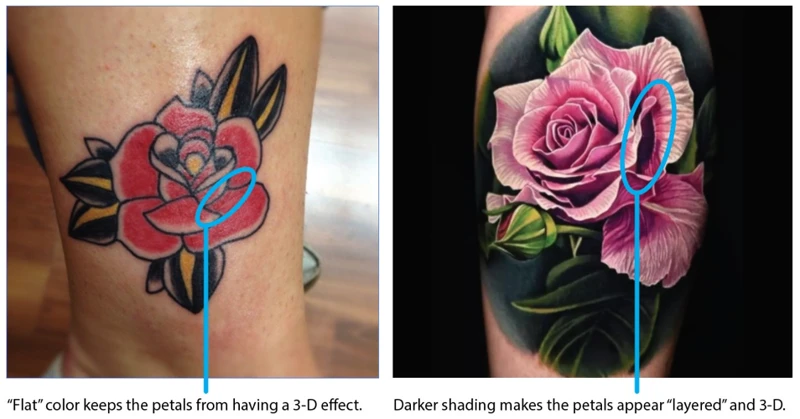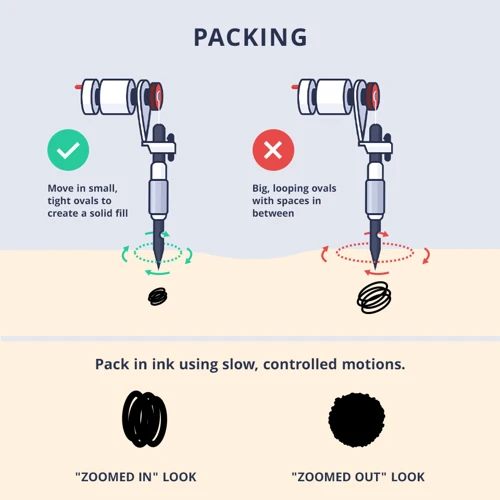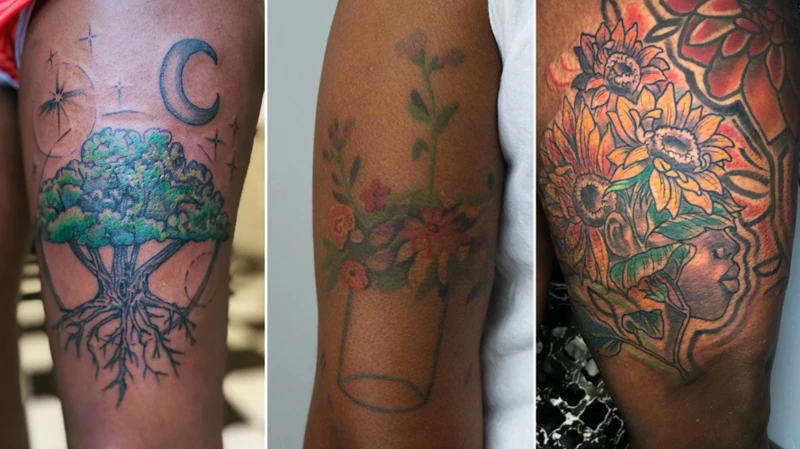Are you an artist looking to learn how to shade a tattoo with color? If so, you are in the right place! In this article, we will provide professional tips that will help you to create a perfectly shaded tattoo. We will discuss the importance of using the right colors, the best ways to achieve a smooth transition between colors, and various techniques you can use to achieve the desired design. With the help of these tips and tricks, you will be able to create stunning tattoos with beautiful shading. So, let’s get started!
Contents
Preparing to Shade a Tattoo with Color

Supplies Needed
Before starting to shade a tattoo with color, it is important to have the necessary supplies on hand. You will need a wide range of tattoo ink, needles, and other related items, such as a tattoo stencil, needle caps, and a sanitizing solution. It is important to have the right tools in order to create a perfect tattoo.
Preparing the Skin
The skin must be properly prepared before beginning to shade a tattoo with color. This involves cleaning the skin with a mild soap and water solution and then drying it off with a clean towel. Additionally, the area should be shaved and the skin should be stretched out to ensure the color will stay in place.
Measuring and Sketching
Once the skin is prepared, it is time to begin measuring and sketching the area where the tattoo will be placed. This will help to ensure that the design and shading will be even and symmetrical. A ruler and measuring tape can be used to measure the area and a sketching pencil can be used to draw out the design before shading.
Finally, it is important to remember that when shading a tattoo with color, it is important to use a slow and steady hand and to make sure that the color is applied evenly. The goal is to achieve a solid black tattoo, so it is important to take your time and be precise with the shading process.
How to Shade a Tattoo with Color

Shading a tattoo with color is an art form, and creating a perfectly shaded tattoo requires practice and skill. Here are a few tips for professional tattoo artists to help create a stunningly shaded tattoo.
Blending and Filling in Color
The first step in shading a tattoo with color is to blend and fill in the colors. It is important to use a thin line for shading, as this gives the tattoo a more natural and realistic look. To ensure the colors blend together smoothly, use a light touch and gradually build up the color. It is also important to use the right amount of color – too little and the tattoo will look washed out, while too much color can make the tattoo look too intense.
Creating Contrast and Depth
To give the tattoo a realistic look, it is important to create contrast and depth. This can be achieved by using different shades of color to add depth and by using highlights and shadows to create contrast. It is also important to use the right colors – lighter colors should be used for highlights, while darker colors should be used for shadows.
Fine-tuning the Details
Once the colors have been blended and filled in, the tattoo artist can fine-tune the details to make sure the tattoo looks perfect. This includes making sure the colors are even and the lines are straight. It is also important to make sure the tattoo is not too watery, as this can detract from the overall look.
By following these tips, you can create a perfectly shaded tattoo with color. Whether you are shading a black and grey tattoo or a full-color tattoo, these tips will help ensure that your tattoo looks stunning.
How to Shade a Solid Black Tattoo

Choosing the Right Ink
When shading a solid black tattoo, the most important factor is choosing the right ink. Black ink should be rich and dark, so that it stands out when shaded. It is important to select an ink that does not contain any fillers, as these can cause a smudging effect that can ruin the artwork. Additionally, it is essential to use a high-quality, vegan-friendly ink for the shading.
Applying the Ink
When applying the ink to the skin, it is important to use a steady hand and light pressure. It is best to start with a thin layer of ink, and gradually build up the shade as needed. It is important to avoid pressing too hard with the tattoo gun, as this can cause the ink to become too dark. Additionally, it is important to use a slow, steady motion when shading, as this will help to create a more even and consistent shade.
Blending, Contouring and Finishing
Once the initial layer of ink has been applied, it is important to blend and contour the shading. This can be done by using a slightly darker shade of ink to add depth and definition to the tattoo. Additionally, it is important to use a soft brush to feather and blend the ink, as this will help to create a smoother, more natural-looking shade. Finally, it is essential to use a high-quality sealant to protect the tattoo and ensure that the color will stay vibrant for longer.
These tips will help you create a perfectly shaded black tattoo. With the right techniques and a steady hand, you can create a beautiful, long-lasting piece of body art.
How to Color in a Tattoo Black

Choosing the Right Ink
When shading a tattoo with black pigment, it is important to choose the right kind of ink. Most professional tattoo artists use a ‘true black’ pigment, which is a combination of several different shades of black to create a deep, dark black. This is the best type of ink for producing a rich, solid black tattoo, as it has a very high pigment content.
Applying the Color
When it comes to shading a tattoo with black, the most important thing is to take your time and build up the layers of color gradually. Working quickly and carelessly can create an uneven, splotchy look, so it is best to go slow and steady. Start by dipping your needle into the ink and lightly outlining the areas you want to shade. Then, use a low-frequency machine to fill in the lines with a thin layer of black.
Blending, Contouring and Finishing
Once you have filled in the lines with the black ink, you can begin to blend the colors together. This can be done by using a liner needle to create a soft, gradual transition between the black and the other colors. You can also use a shader needle to add contours and highlights to the tattoo. Finally, use a damp cloth to gently wipe away any excess ink, and you are ready to go.
Remember: Patience is key when shading a tattoo with black ink. Take your time to build up the layers of color gradually, and you will end up with a perfectly shaded tattoo.
Aftercare
- Keep it clean: Gently wash the tattoo with lukewarm water and an antibacterial soap twice a day to keep the area clean.
- Moisturize: Moisturize the tattooed area twice a day with a fragrance-free moisturizer to keep the skin hydrated.
- Protect it: Apply a thin layer of petroleum-based ointment to the tattooed area and cover it with a bandage for the first 24 hours after getting the tattoo.
- Avoid the sun: When possible, keep the tattoo out of direct sunlight to avoid fading or discoloration.
- Be patient: Allow the tattoo to heal properly, which can take up to two weeks.
Frequently Asked Questions
What are the Best Tools to Use when Shading a Tattoo?
The tools used for shading a tattoo vary depending on the desired outcome, but the general tools used include magnum needles, rounds, flat shaders, and liners. Magnum needles are best for shading larger areas of the tattoo, while rounds are great for creating a more detailed look. Flat shaders are ideal for laying down large areas of color, and liners are perfect for outlining and creating fine lines. Additionally, using a shading brush can help to create soft transitions between colors.
How Can I Ensure That the Colors Blend Together Well?
- Mix colors in a consistent manner – To ensure that your colors blend together well, mix them together in a consistent manner. This means that if you are using multiple colors, you should mix them together in the same ratio, with the same amount of each color. This helps to ensure that the colors blend together seamlessly.
- Use colors that complement each other – Think about what colors pair well together, and use those colors to create your tattoo. For example, yellow and orange blend together nicely, as do blue and green. Use these color combinations to create a tattoo that looks aesthetically pleasing.
- Create a color palette – Before you begin shading your tattoo, create a color palette with the colors that you plan to use. This will help you to keep track of the colors that you are using and ensure that the colors blend together nicely.
- Test the colors – Before you start shading your tattoo, test the colors out on a separate piece of paper. This will help you to see how the colors interact with each other and ensure that the colors blend together well.
What techniques should I use to create a realistic shadow effect?
- Create depth – The best way to create realistic shadows is to add depth to the tattoo. This can be done by adding more ink to darker areas, which will create a deeper, more realistic shadow.
- Use contrast – Contrast is key when creating realistic shadows. Darker areas should be shaded with darker ink, while lighter areas should be highlighted with lighter ink.
- Be mindful of the light source – Where the light source is coming from will determine where the shadows fall. If the light source is coming from the left, the shadows will be on the right. If the light source is coming from the top, the shadows will be on the bottom.
- Blend shades – To create a realistic shadow effect, shades of ink should be blended together to create a smooth transition from light to dark.
- Create highlights – Highlights are an important element of creating realistic shadows. The lighter areas of the tattoo should be highlighted with a lighter color.
How can I make sure the tattoo looks the same after healing?
- Choose a reputable tattoo artist: It is important to choose an experienced tattoo artist who is familiar with the shading and coloring techniques. They should be able to advise you on the best colors and shading to use for your desired result.
- Follow aftercare instructions: After getting the tattoo, be sure to follow the aftercare instructions given by the tattoo artist. This includes avoiding direct sunlight, using ointment, and keeping the tattoo moisturized. This will help ensure that the colors remain vibrant and the shading remains intact.
- Use quality tattoo inks: Quality tattoo inks will help ensure that the colors remain vibrant and the shading remains intact after the tattoo has healed. Be sure to ask your tattoo artist what brands they use and if they have any recommendations for the best inks.
- Avoid swimming and soaking: After getting a tattoo, it is important to avoid swimming and soaking the tattoo in water. This will help keep the colors and shading from fading or running when the tattoo is healed.
What are the Benefits of Using Shading in a Tattoo?
Shading can make a tattoo look much more realistic and dynamic. It can create a sense of depth and add texture and dimension to the tattoo. Here are some of the benefits of using shading in a tattoo:
- Shading can create a more realistic and dynamic look to the tattoo.
- It can bring out the details of a tattoo, making them stand out.
- Shading can create a sense of depth, making the tattoo more lifelike.
- It can add texture and dimension to a tattoo, making it look more three-dimensional.
- Shading can add emphasis to certain areas of the tattoo, drawing the eye to certain elements.
- It can be used to make a tattoo look more vibrant and vivid.
Shading can be a great way to make a tattoo look more dynamic and lifelike. It can also be used to add emphasis to certain areas of the tattoo, making it stand out more. With the right techniques, shading can be used to make a tattoo look more vibrant and vivid.
Conclusion
Shading a tattoo with color is a complex task that requires skill, patience, and practice. By following the professional tips outlined in this article, you can create a perfectly shaded tattoo that looks beautiful and vibrant. With practice, you can develop your shading skills and create amazing tattoos.